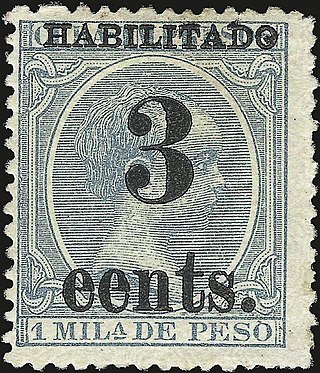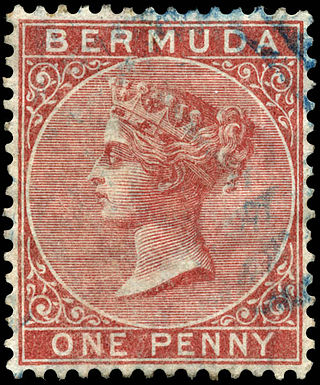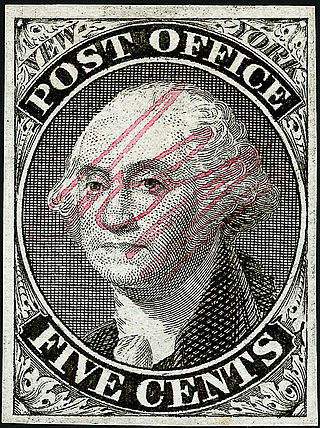Related Research Articles

Philately is the study of postage stamps and postal history. It also refers to the collection and appreciation of stamps and other philatelic products. Philately involves more than just stamp collecting or the study of postage; it is possible to be a philatelist without owning any stamps. For instance, the stamps being studied may be very rare or reside only in museums.

A postage stamp is a small piece of paper issued by a post office, postal administration, or other authorized vendors to customers who pay postage. Then the stamp is affixed to the face or address-side of any item of mail—an envelope or other postal cover —which they wish to send. The item is then processed by the postal system, where a postmark or cancellation mark—in modern usage indicating date and point of origin of mailing—is applied to the stamp and its left and right sides to prevent its reuse. Next the item is delivered to its addressee.

The United States Post Office Department was the predecessor of the United States Postal Service, established in 1792. From 1872 to 1971, it was officially in the form of a Cabinet department. It was headed by the postmaster general.

Postal service in the United States began with the delivery of stampless letters whose cost was borne by the receiving person, later encompassed pre-paid letters carried by private mail carriers and provisional post offices, and culminated in a system of universal prepayment that required all letters to bear nationally issued adhesive postage stamps.
This is a list of philatelic topics.

The postage stamps and postal system of the Confederate States of America carried the mail of the Confederacy for a brief period in American history. Early in 1861 when South Carolina no longer considered itself part of the Union and demanded that the U.S. Army abandon Fort Sumter, plans for a Confederate postal system were already underway. Indeed, the Confederate Post Office was established on February 21, 1861; and it was not until April 12 that the American Civil War officially began, when the Confederate Army fired upon US soldiers who had refused to abandon the fort. However, the United States Post Office Department continued to handle the mail of the seceded states as usual during the first weeks of the war. It was not until June 1 that the Confederate Post Office took over collection and delivery, now faced with the task of providing postage stamps and mail services for its citizens.

The American Letter Mail Company was started by Lysander Spooner in 1844, competing against the legal monopoly of the United States Post Office.
The United States Postal Service's Citizens' Stamp Advisory Committee (CSAC) evaluates potential subjects for U.S. postage stamps and reports its recommendations to the Postmaster General, who makes the final decision.

Linn's World Stamp Almanac defines a provisional stamp as "a postage stamp issued for temporary use to meet postal demands until new or regular stocks of stamps can be obtained."

Lawrence Lewis Shenfield was an advertising executive who was instrumental in promoting the development of radio broadcasting during its golden age of the 1920s and 1930s. Larry lined up sponsors to help further the popularity of such stars as Orson Welles and Dinah Shore. After his retirement, Larry developed a second career as a prominent philatelist internationally recognized in the field of postal history. His careful studies of the postage stamps and postal history of the Confederate States are relied upon by stamp collectors and experts in philately to the present day.
The Stamp Specialist is the title of a series of books on philatelic research written and edited for the advanced collector of postage stamps.

August Dietz was a philatelist, editor and publisher, who specialized in the study of mail and postal history of the Confederate States of America.
John Robert Boker Jr. was an American philatelist who amassed some of the most prestigious collections of 19th century stamps ever seen by stamp collectors. Before his death in 2003, the Collectors Club of New York declared him, in 1996, to be the "outstanding philatelist of the last half of the twentieth century."
Charles Haviland Mekeel, of St. Louis, Missouri, was a well-known stamp dealer and editor. He figured prominently in the 1895 “find” of the St. Louis Postmaster Provisionals, which solved problems related to their authenticity.
The Confederate Stamp Alliance is a philatelic organization dedicated to the collection and study of postage stamps and postal history of the Confederate States of America (CSA). It is an affiliate of the American Philatelic Society.
Jerry S. Palazolo of Memphis, Tennessee, is a collector and expert of postage stamps and postal history of the Confederate States of America. He is also owner of a retail wine and liquor business.

Bermuda, a group of islands in the North Atlantic Ocean, was previously uninhabited when the British established a settlement in 1612.

The St. Louis Bears are a set of Provisional stamps issued by the St. Louis Post office in 1845-46 to facilitate prepayment of postal fees at a time when the United States Post Office had not yet issued postage stamps for national use. St. Louis, whose postmaster, John M. Wimer, instigated the production, was one of eleven cities to produce such stamps. Bears were offered in three denominations: 5¢, 10¢ and 20¢; the earliest known postmark date on a stamp of the issue is November 13, 1845.

The New York Postmaster's Provisional is, as its designation implies, a postage stamp provided by the New York Post Office to facilitate the prepayment of mail at a time when the United States had not yet issued postage stamps for national use. Placed on sale on July 14, 1845, this was the nation's first provisional stamp to be issued by a local post office in response to the congressional postal reform act that had taken effect two weeks earlier. That law, passed on March 3, 1845, standardized nationwide mail rates, with the result that the use of stamps became a practical and reliable method of postal prepayment. Before standardization, the many different postal rates in different jurisdictions had made fees too unpredictable to prepay all letters with stamps as a matter of course, with the result that recipients of letters—rather than senders—generally paid the postage on them. Baltimore announced the issue of a provisional stamp one day after New York, on July 15, and New Haven soon followed. The New York issue has been cited as "the most elegantly executed and widely used of the group of provisionals issued by eleven different [U. S. post] offices between 1845 and 1847."

The Commemoration of the American Civil War on postage stamps concerns both the actual stamps and covers used during the American Civil War, and the later postage celebrations. The latter include commemorative stamp issues devoted to the actual events and personalities of the war, as well as definitive issues depicting many noteworthy individuals who participated in the era's crucial developments.
References
- ↑ "Items for Sale - Philatelic Literature". www.trishkaufmann.com. Retrieved 2021-07-23.
- Francis J. (Frank) Crown, Jr. Archived 2009-11-13 at the Wayback Machine